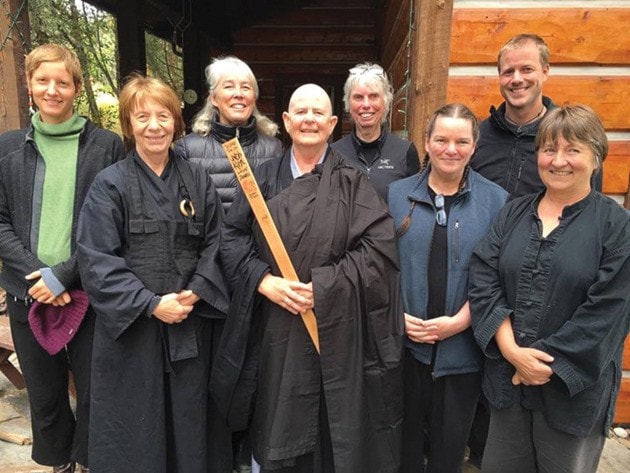“I look a bit like Yoda now,” says Kuya Minogue as she laughs and rubs her freshly shaved head. Recently ordained a Soto Zen priest, Minogue is now focusing her efforts on teaching and making herself available to others. “I was ordained a priest on September 25th, and that means the focus is no longer on me. I’ll now be making the teachings available for others in any way I can.”
The road to becoming a Soto Zen priest has been a long one. “In 1986, I escaped an abusive relationship and couldn’t find the help I needed. I happened to walk into the local library, and there were piles of discarded books in the bin by the front door. I found a copy of The Teachings of the Compassionate Buddha for a couple dollars and read the entire book that night. On the inside of the back cover was a stamp and phone number for a meditative hall in Eugene, Oregon. I called them up and went to visit. When I arrived, I looked into the priest’s eyes and saw exactly what I wanted. I made a decision at that moment to focus my life on Zen. I started to learn the process of letting go – a release of self-centeredness.”
From then, Minogue has lived a monastic life, meditating and supporting Zen practice. After ten years teaching in remote First Nations communities, she moved to Creston and started the Zendo in 2007. “I started it out of the basement of my house, then from a back room, and then I had the Zendo built with two residence rooms,” says Minogue. “Now that I’m a priest, visitors can do residential training. Anyone can come and join my practice schedule. I personally meditate around 5:00 a.m., but public sittings are usually around 8:00 a.m. or 9:00 a.m.”
Minogue spends her days studying Zen texts and participating in the Silent Thunder Order, in which she was ordained. “I take part in Dharma discussions, where we choose a text and discuss the teachings over Skype with members from around the world. But being a priest means I can now do weddings and other legal activities.”
Minogue wants to acknowledge those that traveled to her ordination. “My first student from Kitimat came, and six friends from Creston. It was a significant community event in Dayton, Montana. I had to sit for five hours a day for three days, but it was a wonderful experience. You can’t see any suffering in my face when you look at the picture,” she says with a big smile.
Minogue also wants to acknowledge the many hours the people of Creston spent helping to sew her robe for the ceremony. “Because of my arthritis and poor eye sight, I needed help. It’s tradition that it has to be sewn by hand. Eighteen different people helped, line-by-line. Along the way, it was sent for approval. Sometimes it went well, and other times it didn’t.” She laughs again. “Attachment grows like hair,” she says, rubbing her head again.
“It is estimated to be about 20,000 stitches. It was a good lesson in letting go and living in the moment. Part of me just wanted to get it done, but I had to slow down and focus. I needed to see a whole life in one stitch.”
Starting October 11th, Minogue will be doing a 10-week monastic residency called ango in California, at the Green Gulch Farm Zen Center outside San Francisco. “Part of the process requires that I sit outside for two days. This is called tangaryo and, traditionally, it was five days long. It’s meant to test my resolve.
Minogue will return to Creston in late December and begin teaching classes in January.
